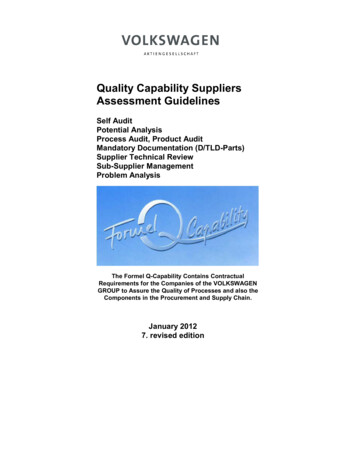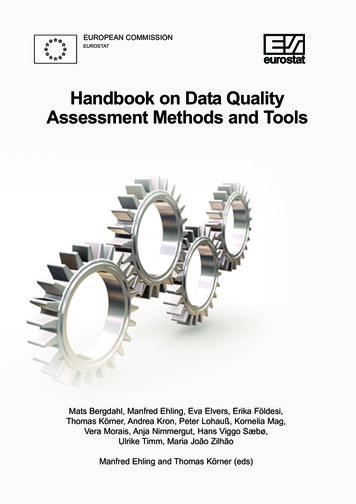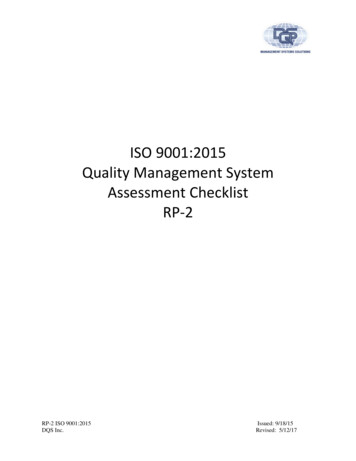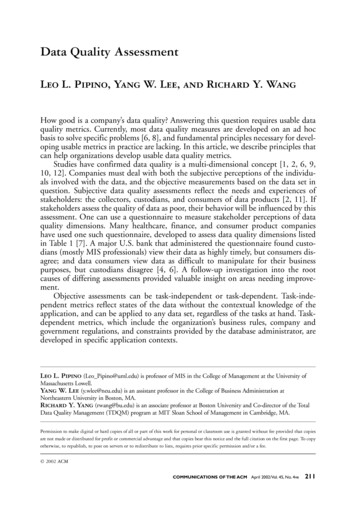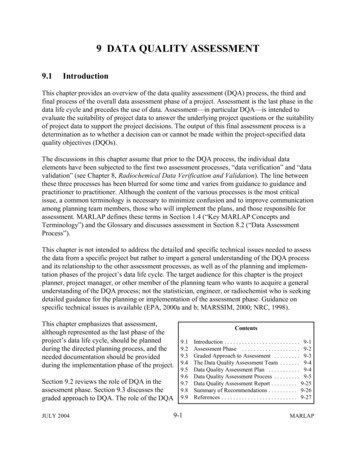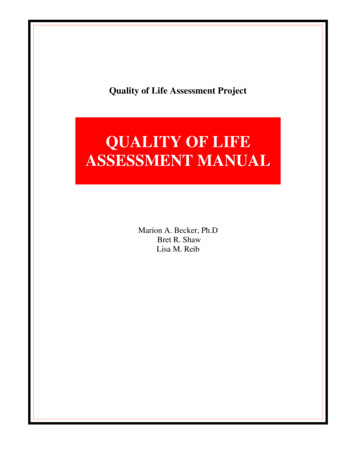
Transcription
Quality of Life Assessment ProjectQUALITY OF LIFEASSESSMENT MANUALMarion A. Becker, Ph.DBret R. ShawLisa M. Reib
Quality of Life Assessment ManualTable of ContentsIntroductionPreface . 1Historical Context. 1The Wisconsin Quality of Life Index . 2Validation of the Instruments . 2Cultural Translations . 3Introduction to Coding and Scoring . 4W-QLI Conceptual Model . 5Example of Individual QoL Data from Client and Provider Perspectives . 6Example of Aggregate QoL Data Display. 7Taxonomy of Goals . 8Wisconsin Quality of Life Index (W-QLI) Client QuestionnaireConceptual Framework . 9Questionnaire. 12Wisconsin Quality of Life Index (W-QLI) Provider QuestionnaireConceptual Framework . 21Questionnaire. 23Wisconsin Quality of Life Index (W-QLI) Caregiver QuestionnaireConceptual Framework . 29Questionnaire. 31Quality of Life Index for Adults (A-QLI) QuestionnaireConceptual Framework . 39A-QLI Conceptual Model. 41Questionnaire. 42Quality of Life Index for Adults (A-QLI) Provider QuestionnaireConceptual Framework . 52Questionnaire. 53The Family Quality of Life Index (F-QLI)Conceptual Framework . 60F-QLI Conceptual Model . 62Questionnaire. 63The Family Quality of Life Index (F-QLI) Provider QuestionnaireConceptual Framework . 75Questionnaire. 76W-QLI User Agreement . 82A-QLI and F-QLI User Agreement . 83Requesting an Index . 84Preface
Quality of life (QoL) is fast becoming a standard measure of outcomes in clinical trials, costeffectiveness analysis and clinical practice. A confluence of forces including rising health care costs,concern over reported poor QoL of psychiatric patients living in the community and an awakeningrecognition that customary measures of treatment measures are inadequate has focused attention on theneed to measure and improve QoL for persons with mental illness. Unfortunately, methods forcombining clinical data with client perceptions and goals for improvement with treatment are notstandardized. In addition, there are likely to be differences about the relative importance of differentdomains. Clinicians, families and the clients themselves may have a very different view of the client’sQoL and the important goals of therapy. Quality of life is a subjective construct which varies with thepopulation studied. It is generally conceptualized as a multi-dimensional construct made up of a numberof independent domains including physical health, psychological well-being, social relationships,functional roles and subjective sense of life satisfaction. Each QoL domain can be assessed from thepoint of view of the clinician, client or caregiver, and the relative weighting of the importance of eachdomain can also vary from one observer to another.This Quality of Life Assessment Manual is an introduction to seven QoL assessment measuresdeveloped by the Quality of Life Assessment Project at the University of Wisconsin - Madison. Themanual provides an overview of QoL assessment for three distinct groups including families, olderadults and adults with serious mental illness. This document also describes the conceptual frameworkfor the instruments and illustrates some of the ways that outcome data may be presented and used. Theinstruments presented here embody a multi-disciplinary approach to outcomes and present the work of adiverse team of researchers from the University of Wisconsin - Madison including:Principal InvestigatorMarion A. Becker, Ph.D., RNSocial Work, Nursing & GerontologyCo-Principal InvestigatorRonald Diamond, MDPsychiatryCo-InvestigatorsFrancois Sainfort, Ph.D.Jeffery Douglas, Ph.D.Industrual EngineeringBiostatisticsResearch AssistantsEric Grodsky, M.A.Bret R. Shaw, M.A.Lisa M. ReibSociologyJournalism and Mass CommunicationJournalism and Mass CommunicationHistorical ContextThe Quality of Life Assessment Tools provided in this manual were developed for clinical and researchuse. The first Wisconsin Quality of Life Index (W-QLI) was developed for use in mental health inresponse to a need to provide appropriate information in the Wisconsin Medicaid Program forreauthorization of clozaril. Clozaril was then a new and expensive antipsychotic medication. At thetime of development, outcomes in psychiatric patients were being measured predominantly in terms ofsymptoms. In fact, the Medicaid programs in 30 of 50 states in America were using a symptomimprovement criteria for reauthorization of the drug under Medicaid reimbursement. Most were using a
20 percent symptom improvement criteria based on outcome measured with the Brief Psychiatric RatingScale.(1). When clozaril was approved for use, the field lacked an inexpensive, easy-to-use,comprehensive QoL assessment tool for use in busy mental health settings.Our primary objective was to develop an inexpensive, easy-to-use, self-report and self-administeredinstrument that would reflect consumer values and goals for improvement with treatment. An advisoryboard was convened to guide the scale development and ensure that consumer needs were incorporated.We realized that the clinical and practical usefulness of an assessment instrument would be key to itssuccessful adoption and use in the field. Thus, we developed an instrument that could be used to assesspatient status, and that could also be used for monitoring and evaluating patient outcomes over time.Important features of all QoL instruments developed by the principal investigator are theirdimensionality, inclusion of consumer goals, and provisions for multiple respondents. Descriptions ofthe index domains and underlying conceptual frameworks are provided in subsequent sections of thismanual. The multi-dimensional conceptual model for the W-QLI is found on page 5.The Wisconsin Quality of Life IndexThe Wisconsin Quality of Life Index (W-QLI) for use in mental health has been made available toinvestigators in community settings, academia and the pharmaceutical industry. In exchange for earlyaccess to the W-QLI, anonymous data sets have been provided to the developers for psychometricevaluation. Early application studies were primarily conducted in community support programs(CSP’s). However, the W-QLI has also been used in hospital settings, clinical trials, a private doctor’soffice, and mental health care units of health maintenance organizations.Studies currently in the field in the United States focus primarily on persons with chronic mental illness.The majority of responders have carried a diagnosis of schizophrenia, although the W-QLI has also beenused in a populations of persons with borderline personality disorder and with major affective disorder.The W-QLI has been used for program evaluation as well as for the purpose of comparing outcomes ofdifferent service models (i.e. a Program for Assertive Community Treatment (PACT) and a FountainHouse Model Program).Validation of the InstrumentsThe W-QLI index was field tested for clients and providers by using local mental health providersknown to the authors. Results of the initial validation work have been reported in detail elsewhere.(2) Inorder to ensure content and face validity of the W-QLI, we based the conceptual framework and thedevelopment of the instrument on a comprehensive model of QoL that includes multiple dimensions aswell as multiple perspectives on the client’s QoL. Furthermore, both consumers and professionalsconsidered to have expertise and extensive experience with persons suffering from severe and persistentmental illness were involved in the development, definition and choice of items and/or scales to beincluded to represent these multiple dimensions of life quality. Finally, to the extent possible, existingvalid scales were chosen to capture some aspects of the various domains and dimensions of QoL.(1)See The brief psychiatric rating scale, (p. 799-812) by J. Overall, D. Gorham, 1962, PsychologicalReport, Vol 10.(2)See A new patient focused index for measuing quality of life in persons with severe and persistentmental illness, (p. 239-251) by M. Becker, R. Diamond, F. Sainfort, 1993, Quality of Life Research, Vol2.
The Quality of Life Index for Older Adults and the Family Quality of Life Index are newer instrumentsin their initial stages of evaluation. They are designed to follow the conceptual framework of the WQLI.Cultural TranslationsThe W-QLI has been culturally adapted/translated and harmonized for use in 12 countries usingaccepted international guidelines. Available translations include Afrikaans, Australian, Austrian,Canadian, Canadian French, Dutch, English, Finnish, French, German, Hebrew, Italian, JapanesePortuguese and Spanish. Efforts are currently underway in Canada, Italy and Spain to collect generalpopulation norms for the W-QLI.Cultural Adaptation Methodology:Cultural adaptation of the W-QLI was funded by in part by Janssen Research Foundation. Janssenwished to use the W-QLI to assess QoL of individuals suffering from schizophrenia. They contractedwith Mapi Values in Lyon, France, who directed the work of the cultural adaptation using the followingmethodology: Recruitment of a QoL specialist as project manager in each of the countries involved. Production of two independent forward translations of the original questionnaire by twoindependent professional translators, native speakers of the target language and bilingual in thesource language. A meeting between the forward translator(s) and the project manager to compare both forwardtranslations and to establish a reconciled version. Production of a backward translation of the reconciled forward translation into the source languageby one professional translator, native speaker of the source language and bilingual in the targetaudience. A meeting between the backward translator and the local project manager to compare the backwardtranslation and the original, discuss discrepancies and possibly modify the reconciled translation intothe target language. Discussion of the discrepancies between the back translation and originalsource questionnaire between the local project manager and Mapi Research Institute and agreementon the changes to be made to the reconciled translation. Cognitive Debriefing: the test of the target language translation established in the light of thebackward translation, is usually carried out on five patients suffering from the condition beinginvestigated and native target language speakers. However, due to the complex nature ofschizophrenia and the effect that this condition has on patients who suffer from it, it was decided torecruit three healthy subjects and two subjects suffering from schizophrenia. This form ofrecruitment allowed for a more subjective assessment of the clarity, appropriateness andacceptability of the translated questionnaire, which was followed by integration of the results intothe reconciled translation.
An international harmonization meeting during which the translations, modified according to theoutcome of the cognitive debriefing, were compared to all the other translations as well as theoriginal in order to ensure conceptual equivalence throughout all versions. Establishment of a final version in the target languages according to the outcome of internationalharmonization. Revision of the lay-out to facilitate completion of the questionnaire. This was done in collaborationwith Janssen Research Foundation and submitted to Marion Becker for approval.Introduction to Coding and ScoringThis section provides an overview of the general steps to accomplish before coding, data entering andscoring the QoL questionnaires covered in this manual.Whenever possible the questionnaire completion process should be supervised. Clients should beassisted to complete the self-report, self administered information requested and the questionnairesshould be reviewed for completeness when they are returned. If the questionnaire has been administeredas an interview, the client’s choices and goals should be recorded verbatim and the interviewer shouldnot influence the responders answer.Performing Scoring Checks. Determine the completeness of the scale scoring. In general, werecommend that scale scores not be calculated if half or more of the scale items are missing. Computeraw scale scores according to the calculations provided in the coding and scoring directions for the scaleused. Coding books are available from the principle investigator upon request. Outcome scores andinformation can be used in a variety of ways. On the following pages, we provide examples of ways todisplay and use the data for individual and clinical use. We continue to work on the development ofoptimal ways to format the data.In collaboration with Alvan R. Feinstein, MD, we have developed a taxonomy for evaluating the goalsdomain. This taxonomy which appears on page 7 is used to categorize the goals. The taxonomicnumber can be used to analyze goals by responder type (i.e. client, clinician or caregiver) and acrossclinical settings.
Wisconsin Quality of Life IndexMulti-Dimensional Conceptual Model for Evaluating Quality of LifeCharacteristicsetiv Caregivercpe ProviderrseP ClientDimensionsAbsolute score Change score ImportanceLife SatisfactionOccupational ActivitiesPsychological Well BeingPhysical HealthSocial iQjQ.Q. Evalutaion of a particular dimension with respect to a particular characteristic. Evaluation of dimension across characteristics. Evaluation across dimensions. Evaluation of Quality of Life as a whole (perceived QoL)
Example of Individual Level Data PresentationLooking at Client’s Quality of Life from Client and Provider PerspectivesExamples of Client Questionnaire Aggregate Data Presentation
for Use in Clinical and Program EvaluationAggregate Data for Assertive Community Treatment ProgramGeneral SatisfactionOccupational ActivitiesActivities of Daily cal HealthSocial Relations / SupportMoneyQuality of Life ScoreWeighted Quality of Life ScoreMeanStd. 3Aggregate Data for Self-Help Day ProgramGeneral SatisfactionOccupational ActivitiesActivities of Daily cal HealthSocial Relations / SupportMoneyQuality of Life ScoreWeighted Quality of Life ScoreMeanStd. -.71-.713.003.003.003.002.332.33464649392928Data can also be presented in aggregate form and used to compare the outcome of clients in differentprograms or to compare outcomes of different populations. For example, the above data provides abasis of comparison for outcomes between two programs. The top table contains data from a Programfor Assertive Community Treatment (PACT) and the bottom table contains data from a self-help dayprogram. The W-QLI project team has begun to investigate a number of questions using the W-QLI toexamine outcomes for different populations including persons with and without co-occurring serioussubstance abuse problems and persons with and without hope for the future.
Outline of Categories: Taxonomy of TreatmentGoals for Improvement of Persons with SchizophreniaProposed by Clients, Clinicians, and Families1.1.1Control of DiseaseManifestation of Illness1.1.1. Cardinal Manifestations of Schizophrenia1.1.1.1 Thought Disorders1.1.1.2 Auditory Hallucinations2.2.1Personal StatusSelf Care2.1.1. ADL2.1.2. Other (e.g. coping skills)2.1.3. Gain or lose weight1.1.2. Mental Stability1.1.2.1. Achieve Mental Stability1.1.2.2. Maintain Stability2.2Independence2.2.1. Domiciliary Issues2.2.1.1. Deinstitutionalization2.2.1.1. Domiciliary Independence2.2.2. Finances2.2.3. Occupation2.2.4. Education2.2.5. General Function2.3Sense of Well Being2.3.1. “Improve Self-Esteem”2.3.2. “Be Happier”3.Interpersonal Status3.1Family Relationships3.1.1. Parent(s)3.1.2. Spouse3.1.2. Child(ren)1.1.3. General Manifestations1.1.3.1. Aggression & Anxiety1.1.3.2. General Mental Health1.1.3.3. “Be on Level Keel”1.1.4. Co-morbidity1.1.4.1. Alcoholism1.1.4.2. Substance Abuse1.2Therapy1.2.1 Regulation of Medication1.2.2. Compliance1.2.3. Other (e.g. day treatment)1.3Side Effects of Therapy1.3.1. Tardive Dyskinesia1.3.2. Parkinsonism3.2Non-Family Relationships3.2.1. Personal Relationshipsand Friends3.2.2. Relationships at Work3.3.Social Functioning3.3.1. Social Interaction3.3.2. Social Independence4. Cargiver Relief4.1 Less Dependence on Parent(s)4.2 Less Dependence on Spouse/Partner4.3 Less Dependence on Paid Providers5. Other Treatment Goals5.1 “A Place of Healing”5.2 “Maintaining Hope for Future”WISCONSIN QUALITY OF LIFE INDEX
CLIENT QUESTIONNAIRECONCEPTUAL FRAMEWORKThe Wisconsin Quality of Life Index (W-QLI) Client Questionnaire is a comprehensive multidimensional measurement tool that reflects the personal priorities and goals of individual mental healthclients. On the basis of previous research, our clinical experience, and recommendations from anadvisory board convened to develop the index, we defined QoL as made up of the following ninedomains: 1) general life satisfaction, 2) activities and occupations, 3) psychological well-being, 4)physical health, 5) social relations/support, 6) economics, 7) activities of daily living, 8) sym
This Quality of Life Assessment Manual is an introduction to seven QoL assessment measures developed by the Quality of Life Assessment Project at the University of Wisconsin - Madison. The manual provides an overview of QoL assessment for three distinct groups including famil







